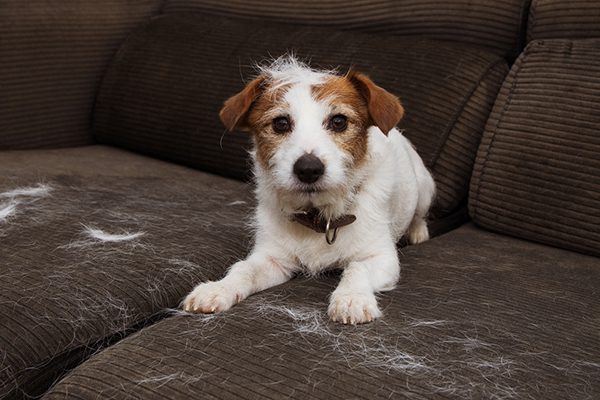Helpful Tips to Reduce Dog Shedding
We all love our furry friends, but sometimes they can be too furry. Dog shedding is part of owning a dog, but there are some things to look out for if you think they might be shedding too much or irregularly.

We’re here to help go over some helpful tips to reduce your dog’s shedding and what to look out for in case they need help from your veterinarian.
Why Do Dogs Shed?
It’s Natural
Some breeds of dogs shed more than others, but shedding in dogs is a natural occurrence. This is how dogs get rid of unneeded or damaged hair from their undercoat. During the winter months, many dogs grow thicker coats of hair to help keep them warm. Then when spring rolls around, they will shed this fur to better regulate their body temperature during the warmer months.
Before bringing a dog home, do research on different dog breeds to have a better understanding of which breeds shed more than others. By doing research first, you will have a better idea of what you are getting into.
Poor Nutrition
One of the main reasons for excessive shedding in dogs is related to a poor diet. If your dog is shedding more than normal, he or she may not be getting the nutrients needed to maintain a healthy coat. It’s important to make sure the food you are giving your dog has enough protein, minerals, and other nutrients that your dog needs to maintain a healthy coat of fur.
Some pet owners have to experiment with different dog foods before they find the best one for their fur baby. Less than ten percent of your dog’s daily food intake should consist of human foods of any kind.
Dehydration can also contribute to your dog shedding excessively. Your dog needs access to fresh, clean water at all times in order to stay hydrated and healthy. If your dog is not adequately hydrated, their skin can become dry and itchy. When dogs are constantly itching, they will lose excessive amounts of fur.
Parasites
External parasites such as fleas, ticks, mites, and lice on your dog can cause your dog to scratch, bite, and chew at their skin which can lead to shedding and hair loss. Internal parasites can also lead to hair loss because this can cause malnutrition in dogs. Ringworms are a fungal infection that also affect your dog’s skin. If your dog has ringworms, you will notice circular patches of fur loss.
Most of the time, these pests and external parasites can be treated with antifungal shampoos or other topical creams and treatments. There are also medications available over the counter or from your vet to help treat internal parasites in dogs. If you are unsure which types of parasites your dog is dealing with, consult with your vet for professional help and advice.
Allergies
Excessive shedding in dogs can also be a result of allergies. Your dog may be taking a certain medication or eating a certain food ingredient that doesn’t agree with them causing them to have an allergic reaction. Other common environmental factors that may cause allergies in dogs include pollen, mold, and dust mites.
Allergies can cause your dog to scratch or chew at irritated places on their skin which will cause shedding and fur loss. If your dog is suffering from allergies, this can usually be treated through medications or changes in their diet.
Illness
Different illnesses and diseases can also cause dogs to shed. Shedding does not mean your dog is sick; however, it can be a symptom of certain diseases. Kidney disease, liver disease, immune diseases, and cancer can all be contributing factors to why a dog is excessively shedding. Your vet can help you rule out any kind of illnesses or diseases.
What to Do About All the Extra Fur
Whether your dog frequently sheds, or doesn’t shed at all, you’ll want to do everything you can to keep their coat healthy. There are some steps you can take to address your dog’s shedding and to keep their coat healthy.
If you feel as though your dog’s shedding is more than a normal amount, you should consult your vet to rule out any medical issues.
Changing Up Your Dog’s Diet
Changing up your dog’s diet can improve shedding. Try switching your dog’s food to a higher quality food that contains protein, minerals, fresh meat, and oils such as sunflower or coconut. You can also try giving your dog omega supplements to help reduce shedding.
Keeping your dog hydrated is also a good way to combat shedding. It can be difficult to keep track of how much water your dog is drinking, but if you notice that your dog is shedding more than normal, be sure to keep an eye on their water bowl. When your dog is dehydrated, their skin becomes drier which is a major cause of hair loss.
Regular Brushing
Brushing your dog regularly will also help with shedding. There are different dog brushes that have different functions. Dogs with shorter hair should be brushed with a natural-bristle brush or a glove with bristles attached.
You can loosen the hair by brushing in the direction of the hair growth or in a circular motion, then you can remove the hair by brushing it the other way. Dogs with longer hair or thick undercoats may need a slicker brush or a shedding tool that can get beneath the outer coat to reach the undercoat.
When you use a brush specifically made for shedding, it is easier to loosen up the hair to help remove it.
Shedding Shampoos Can Help
Shedding shampoos are also great for dogs who shed excessively. Keep in mind that it is normal for your dog to shed some, but if the shedding is more than normal, try adding a special shedding shampoo into their bath routine. These shampoos help keep your dog’s skin moisturized and less irritated. This will prevent your dog from wanting to scratch and itch which dislodges fur.
Bathing your dog regularly will also help with shedding. Bathing not only cleans your dog’s coat, but it also removes dead hair. By loosening and removing your dog’s excess undercoat through regular bathing, you will notice a difference in the amount of fur they shed around your home.
Maintain Your Dog’s Shedding with These Tips
You will never be able to completely stop the shedding, but by using these different tips, you can reduce the amount of shedding in your dog.
As always, Lakeland Animal Clinic is here to help you with all your pet owner questions. When in doubt, give us a call at (863) 688-3338! We are here to help you be your pet’s hero.
Recent Posts
About Us
Family is family, whether it has two legs or four. At Main Street Veterinary Center, we've spent the last 40 years healing and caring for your pets. As a family-operated practice, we know that family is about more than simply being related. Animals give us the ability to develop strong bonds and feel great compassion for a fellow living creature.
